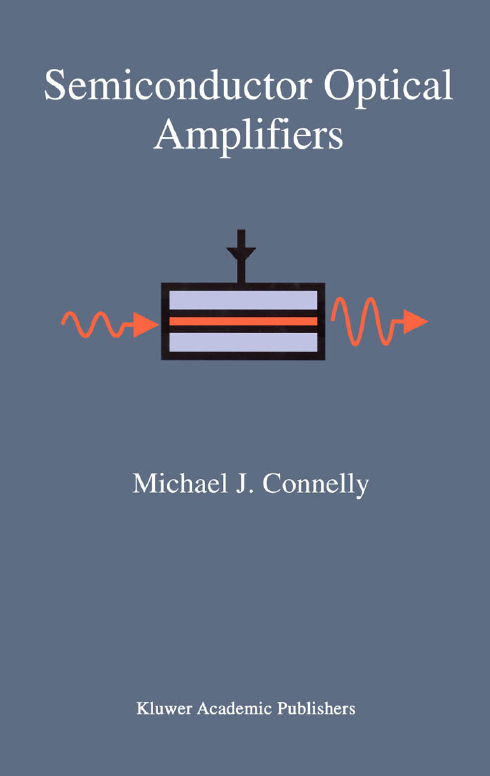�
SEMICONDUCTOR OPTICAL AMPLIFIERS
Semiconductor
Optical Amplifiers
by
Michael J. Connelly
University of Limerick, Ireland
KLUWER ACADEMIC PUBLISHERS
NEW YORK, BOSTON, DORDRECHT, LONDON, MOSCOW
�
eBook ISBN:
Print ISBN:
0-306-48156-1
0-7923-7657-9
©2004 Kluwer Academic Publishers
New York, Boston, Dordrecht, London, Moscow
Print ©2002 Kluwer Academic Publishers
Dordrecht
All rights reserved
No part of this eBook may be reproduced or transmitted in any form or by any means, electronic,
mechanical, recording, or otherwise, without written consent from the Publisher
Created in the United States of America
Visit Kluwer Online at:
and Kluwer's eBookstore at:
http://kluweronline.com
http://ebooks.kluweronline.com
�
For my parents Michael and Margeret
and brother Brendan
�
Contents
Preface
INTRODUCTION
BASIC PRINCIPLES
STRUCTURES
MATERIALS
MODELLING
BASIC NETWORK APPLICATIONS
FUNCTIONAL APPLICATIONS
Index
vii
ix
1
7
21
43
69
97
127
167
�
Preface
Communications can be broadly defined as the transfer of information from
one point to another. In optical fibre communications, this transfer is
achieved by using light as the information carrier. There has been an
exponential growth
in the deployment and capacity of optical fibre
communication technologies and networks over the past twenty-five years.
This growth has been made possible by the development of new
optoelectronic technologies that can be utilised to exploit the enormous
potential bandwidth of optical fibre. Today, systems are operational which
operate at aggregate bit rates in excess of 100 Gb/s. Such high capacity
systems exploit the optical fibre bandwidth by employing wavelength
division multiplexing.
Optical technology is the dominant carrier of global information. It is also
central to the realisation of future networks that will have the capabilities
demanded by society. These capabilities
include virtually unlimited
bandwidth to carry communication services of almost any kind, and full
transparency that allows terminal upgrades in capacity and flexible routing
of channels. Many of the advances in optical networks have been made
possible by the advent of the optical amplifier.
In general, optical amplifiers can be divided into two classes: optical fibre
amplifiers and semiconductor amplifiers. The former has tended to dominate
conventional system applications such as in-line amplification used to
compensate for fibre
in optical
semiconductor fabrication techniques and device design, especially over the
last five years, the semiconductor optical amplifier (SOA) is showing great
promise for use in evolving optical communication networks. It can be
utilised as a general gain unit but also has many functional applications
including an optical switch, modulator and wavelength converter. These
losses. However, due
to advances
ix
�
x
Introduction
functions, where there is no conversion of optical signals into the electrical
domain, are required in transparent optical networks.
It is the intention of this book to provide the reader with a comprehensive
introduction to the design and applications of SOAs, particularly with regard
to their use in optical communication systems. It is hoped that the book has
achieved this aim.
�
















 2023年江西萍乡中考道德与法治真题及答案.doc
2023年江西萍乡中考道德与法治真题及答案.doc 2012年重庆南川中考生物真题及答案.doc
2012年重庆南川中考生物真题及答案.doc 2013年江西师范大学地理学综合及文艺理论基础考研真题.doc
2013年江西师范大学地理学综合及文艺理论基础考研真题.doc 2020年四川甘孜小升初语文真题及答案I卷.doc
2020年四川甘孜小升初语文真题及答案I卷.doc 2020年注册岩土工程师专业基础考试真题及答案.doc
2020年注册岩土工程师专业基础考试真题及答案.doc 2023-2024学年福建省厦门市九年级上学期数学月考试题及答案.doc
2023-2024学年福建省厦门市九年级上学期数学月考试题及答案.doc 2021-2022学年辽宁省沈阳市大东区九年级上学期语文期末试题及答案.doc
2021-2022学年辽宁省沈阳市大东区九年级上学期语文期末试题及答案.doc 2022-2023学年北京东城区初三第一学期物理期末试卷及答案.doc
2022-2023学年北京东城区初三第一学期物理期末试卷及答案.doc 2018上半年江西教师资格初中地理学科知识与教学能力真题及答案.doc
2018上半年江西教师资格初中地理学科知识与教学能力真题及答案.doc 2012年河北国家公务员申论考试真题及答案-省级.doc
2012年河北国家公务员申论考试真题及答案-省级.doc 2020-2021学年江苏省扬州市江都区邵樊片九年级上学期数学第一次质量检测试题及答案.doc
2020-2021学年江苏省扬州市江都区邵樊片九年级上学期数学第一次质量检测试题及答案.doc 2022下半年黑龙江教师资格证中学综合素质真题及答案.doc
2022下半年黑龙江教师资格证中学综合素质真题及答案.doc